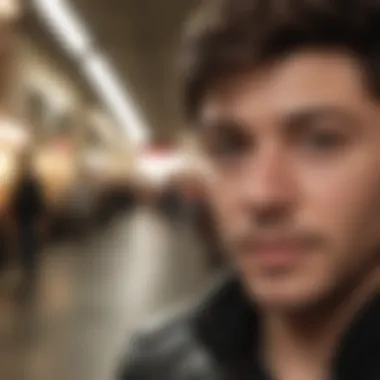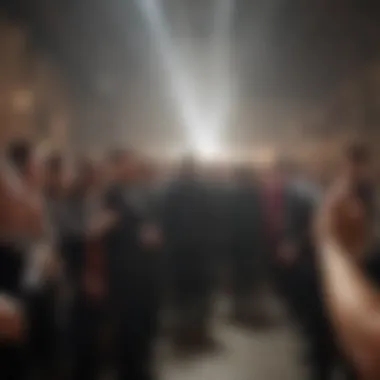Blurred Lines: A Comprehensive Cultural Analysis


Intro
The song "Blurred Lines," released in 2013, is more than just a chart-topping hit. It incited discussions about its lyrical content, cultural implications, and the controversies that followed swiftly after its release. Within its catchy beats and smooth melodies lies a complex tapestry worthy of scrutiny. This exploration aims to dissect the elements that create its resonance in contemporary society, engaging both casual listeners and serious music enthusiasts.
Artist Profile
Biography and Background
Robin Thicke, the artist behind "Blurred Lines," was born on March 10, 1977. Growing up in a musical family, he began working on his craft at an early age. Thicke gained initial fame with his debut album "A Beautiful World" in 2003, but it was his 2013 release, which included "Blurred Lines," that catapulted him to global prominence. The song's infectious groove attracted a wide audience, leading to impressive commercial success.
Major Influences and Inspirations
Thicke cites various artists as major influences on his music. He often mentions icons like Marvin Gaye and Stevie Wonder, whose soulful styles are evident in his work. The aim was to blend contemporary pop with classic soul, thus appealing to a broad range of listeners. This mix showcases his desire to revive classic sounds, bringing them to modern audiences.
Song Analysis
Theme and Lyrics Breakdown
"Blurred Lines" explores themes of attraction and desire. The lyrics, while catchy, have drawn criticism for their suggestive nature. Critics argue it promotes a troubling narrative regarding consent, raising questions about its interpretation. The repetitive phrasing and simplistic word choices create an almost hypnotic effect, which can overshadow the underlying messages.
Some key phrases often debated include:
- Consent issues: Some listeners express discomfort with the song’s approach to consent.
- Gender dynamics: The lyrics depict traditional gender roles, which complicate their reception in modern discourse.
Instrumentation and Composition
Musically, "Blurred Lines" features a blend of funk, R&B, and pop. The use of a minimalist bass line sets the stage for its rhythmic feel, allowing vocal harmonies to shine. The production incorporates elements typical of the disco era, lending it a timeless quality. The catchy hook invites listeners to engage, resulting in a widespread radio presence.
"Blurred Lines" is a cultural artifact, embodying both past musical influences and present societal debates.
In summary, Thicke’s work encapsulates significant aspects relevant to today's discussions about music, intent, and implications. This song, while celebrated in some circles, serves as a focal point for larger conversations regarding modern relationships and cultural norms.
Prologue to Blurred Lines
The song "Blurred Lines" serves as a pivotal point in discussions surrounding modern music. Its impact resonates beyond charts and airplay; it evokes conversations about societal norms, artistic expression, and audience perception. This introduction sets the foundation for exploring various aspects of the song. Understanding its background, creators, and the cultural context in which it emerged is essential for grasping its significance.
By examining these initial elements, readers can appreciate how "Blurred Lines" reflects broader trends in music and society. The ensuing sections will unravel the song's intricate layers, exploring the fusion of musical composition and lyrical themes that have fostered both acclaim and criticism. This exploration not only enriches knowledge but also encourages deeper engagement with contemporary music narratives.
Background of the Song
"Blurred Lines," released in 2013, quickly gained traction across various platforms. The collaboration between Robin Thicke, Pharrell Williams, and T.I. produced a sound that resonated with listeners. The song topped charts in multiple countries, reflecting its widespread appeal.
The lyrical content, while catchy, also ignited debates on its interpretation and implications. Themes of desire and consent are woven into the lyrics, which has led to varying interpretations. Many listeners found themselves captivated by the catchy melody but also challenged by the underlying messages.
Creators and Collaborators
The collaborative effort behind "Blurred Lines" is noteworthy. Robin Thicke, a prominent R&B artist, teamed up with Pharrell Williams, an acclaimed producer and musician known for his versatility. T.I., a renowned rapper, added depth to the track with his distinct flow.
This collaboration was not merely a product of three artists working together; it symbolized a merging of genres. Thicke’s smooth vocal style is complemented by Pharrell’s vibrant production techniques and T.I.’s lyrical dynamism. The synergy among these creators played a crucial role in shaping the song’s overall sound and appeal, marking a significant moment in contemporary music.
Musical Composition


Musical composition plays a crucial role in understanding the distinctiveness of "Blurred Lines." This section examines the genre, style, instrumentation, arrangement, and the production techniques utilized in creating the song. Each element not only contributes to the song's sound but also influences its reception and impact on popular culture.
Genre and Style
"Blurred Lines" is primarily defined as a pop and R&B song, with noticeable influences from funk and soul. This mix of genres is notable for its catchy hooks and danceable rhythms, appealing to a wide audience. The song encapsulates a modern twist on 1970s funk elements, which enhances its accessibility. The blending of these styles showcases Pharrell Williams' and Robin Thicke's inclination towards creating a sound that hearkens back to classic influences while maintaining contemporary relevance.
The style is characterized by upbeat tempos and an infectious groove, which makes it immediately engaging. Understanding this genre fusion is essential for a deeper appreciation of the song's structure and overall musical footprint.
Instrumentation and Arrangement
Instrumentation in "Blurred Lines" reflects a thoughtful arrangement that complements the vocals effectively. There is a prominent use of bass guitars, synthesizers, and rhythmic percussion that establishes a strong groove throughout the track. The song effectively utilizes live instrumentation alongside electronic elements, which brings a unique texture to the sound.
The structure begins with an attention-grabbing intro, setting the tone for the rest of the composition. Layering of instruments is done with precision, allowing each element to shine without overwhelming the listener. The minimalist arrangement means that every component plays a specific role, contributing significantly to the song's overarching feel.
Production Techniques
The production techniques employed in "Blurred Lines" are also noteworthy. The use of vintage recording methods, alongside modern technology, creates an intriguing juxtaposition. The presence of a prominent groove is achieved through syncopation, which allows rhythmic elements to breathe. Techniques such as EQ and compression are likely used to sculpt the final mix, ensuring clarity for each instrument and vocal line.
Additionally, vocal layering and harmonization add to the lushness of the sound, giving a rich texture that enhances listener engagement. The production choices reflect a keen awareness of trends in pop music, making the song feel relevant and fresh upon its release.
"Blurred Lines' is a prime example of how musical composition is key to both enjoyment and emotional response in pop music."
Lyrical Analysis
Lyrical analysis is a crucial component in understanding the broader implications of the song "Blurred Lines." It provides insights into the explicit and implicit messages conveyed through the lyrics. This section focuses on the various themes, interpretations, and cultural implications present within the song. By dissecting the lyrics, listeners can appreciate not just the artistic expression behind them but also the societal reactions they elicit. This enables a deeper understanding of the ongoing dialogues surrounding gender, consent, and artistic freedom.
Themes and Motifs
The themes in "Blurred Lines" are both layered and intricate. Predominantly, the song centers around concepts of desire, attraction, and the nuances of consent. It presents a playful yet contentious view on relationships and romance. This dichotomy makes the song a rich subject for analysis.
Key motifs include:
- Desire: The lyrics portray a sense of longing and seduction.
- Consent: While the song hints at flirtation, it operates within a controversial framework regarding consent
- Freedom: The interplay of wanting and boundaries showcases a notion of freedom in relationships.
- Gender Dynamics: The depiction of male and female roles within the song reflects societal stereotypes and expectations.
Each of these elements is essential for understanding how "Blurred Lines" resonates with listeners and reflects contemporary cultural attitudes.
Interpretation of Lyrics
Interpretation of the lyrics reveals contrasting perspectives. Some listeners view the lyrics as playful and liberating, while others criticize them as problematic. This divergence is important to note.
For instance, when the chorus states, "I know you want it," it can be interpreted as empowering in the context of mutual desire. However, it can also be perceived as overly presumptuous or dismissive of boundaries.
"The ambiguity in these lyrics leads to various interpretations that spark debates about notions of consent in popular culture."
Discussions surrounding these interpretations often lead to significant reflection. They compel both artists and listeners to engage with difficult conversations around relationships and societal norms.
Cultural Implications of Lyrics
The lyrics of "Blurred Lines" intersect with broader cultural conversations. They highlight attitudes toward gender and consent, serving as a reflection of societal values at the time of its release. The song was launched during a period when discussions about sexual harassment, consent, and gender equality were gaining traction.
In the aftermath of the song's release, its lyrics contributed to heightened awareness of these issues. Specific cultural implications include:


- Challenging Gender Norms: The lyrics invite scrutiny of traditional female and male roles.
- Impact on the #MeToo Movement: The controversies surrounding the song made it a focal point in discussions about consent and sexual relations.
- Influence on Future Music: The backlash against the song may have prompted more critical approaches to lyrical content in contemporary music.
In summary, analyzing the lyrics of "Blurred Lines" is essential to understanding the song's place in both musical and cultural arenas. The multifaceted themes and interpretations open a discourse that remains relevant in ongoing dialogues around gender and consent.
Public Reception
The public reception of a song plays a crucial role in determining its legacy and influence within the music industry. In the case of "Blurred Lines," the way it was received by both critics and audiences reflects broader societal attitudes towards music, gender, and artistic expression. This section aims to unpack the various dimensions of this public reception, providing insights into its chart performance, critical reviews, and audience response.
Chart Performance
"Blurred Lines" achieved remarkable success on various music charts globally. Upon its release, it quickly ascended to the top of the Billboard Hot 100, where it remained for a record-breaking twelve consecutive weeks. The song not only dominated charts in the United States but also found its way to the top in multiple countries like the UK, Canada, and Australia. The infectious rhythm and catchy hook contributed significantly to its mainstream appeal.
The commercial success can be attributed to several factors. The blending of genres, particularly pop and R&B, allowed it to reach a wide audience. Furthermore, the strong presence of established artists like Robin Thicke, accompanied by Pharrell Williams and T.I., brought significant attention to the track. The strategic marketing and music video, featuring attractive visuals and dance elements, also bolstered its chart performance. This propelled "Blurred Lines" to become one of the best-selling singles of all time.
Critics' Reviews
Critically, the reception of "Blurred Lines" was notably polarized. Many reviewers praised the song for its catchy melody and production quality. For instance, publications like Rolling Stone and Billboard acknowledged the infectious nature of the track, pointing to its danceability and commercial appeal. Reviews often highlighted the song’s ability to resonate with listeners, tapping into contemporary pop culture.
However, the song attracted significant criticism, particularly regarding its lyrical content. Critics from outlets including The Guardian and Pitchfork argued that the lyrics perpetuate themes of misogyny and blurred consent. Such critiques sparked a larger discourse about the responsibility of artists in addressing complex social issues through their work. This dichotomy in reviews illustrated the challenges of evaluating music that exists at the intersection of entertainment and ethics.
Audience Response
Audience response to "Blurred Lines" further illustrates the complexity of its reception. Initially, many fans celebrated the track for its catchy tune and danceable beat. It became a summer anthem and a staple at parties and events. The energetic vibe resonated with listeners, leading to its viral status on social media platforms.
However, as discussions surrounding its lyrics gained momentum, audience reactions began to shift. The release of nuanced critiques raised awareness among listeners about the implications of the song's message. Movements such as the #AskThicke campaign emerged, encouraging listeners to engage critically with the song rather than simply enjoying it as a catchy hit.
In summary, the reception of "Blurred Lines" serves as a multifaceted case study in understanding how a song can both dominate the charts and provoke significant controversy. The dual narratives of celebration and criticism highlight the ongoing challenges within the music industry regarding content, responsibility, and audience engagement.
Controversies Surrounding the Song
The controversies surrounding "Blurred Lines" are crucial to understanding its impact and legacy. The song did not merely provoke discussions; it ignited debates in the realms of ethics, gender politics, and artistic expression. Delving into these controversies allows us to grasp the multifaceted layers of public response and the implications for the music industry. It reveals how a popular song can become a lightning rod for broader societal issues, influencing the perceptions of art and its responsibilities.
Accusations of Misogyny
One of the prominent accusations against "Blurred Lines" is its perceived misogynistic undertone. Critics argue that the lyrics promote a culture of non-consent and objectify women. The phrase "I know you want it" features prominently in the lyrics, leading to backlash from various advocacy groups. They asserted that it trivializes the issue of consent, suggesting a disregard for women's autonomy.
The controversy intensified when the song was analyzed alongside the context of the #MeToo movement. Many listeners reflected on how the lyrics could be interpreted as reflective of broader societal attitudes towards gender relations. Discussions often center around whether the songwriter's intent was to celebrate flirtation or to perpetuate harmful stereotypes. This narrative surrounding misogyny still resonates today, illustrating the continuing relevance of the song in discussions about gender and representation in media.
Legal Challenges and Lawsuits
Legal challenges also shaped the public’s perception of "Blurred Lines". The most significant legal dispute arose in 2015 when Marvin Gaye's estate sued Robin Thicke and Pharrell Williams. They claimed that the song plagiarized Gaye's 1977 hit "Got to Give It Up". The court ruled in favor of Gaye’s estate, which resulted in a substantial damages award.
This case sparked debates about copyright in the music industry and the fine line between inspiration and plagiarism. The ruling had far-reaching implications. It made artists more cautious about borrowing elements from previous works, perhaps stifling creativity. It also led to discussions about ownership and the evolution of musical genres, influencing how new music is created and produced.
Impact on Artistic Freedoms
The controversies surrounding "Blurred Lines" raised essential questions about artistic freedoms. The debates over misogyny and the legal battles influenced not only the artists involved but also how music is created and critiqued in a broader context. Many artists worry that repercussions from public sentiment can limit their creative expressions.
In an era where social consciousness increasingly influences artistic output, the song became a case study for the balance between freedom of expression and social responsibility. During interviews, artists have expressed anxiety over being labeled or criticized, impacting their willingness to tackle provocative themes.
Ultimately, "Blurred Lines" represents a nexus between contemporary social issues and art. It continues to be a reference point in discussions about what artistic license looks like in an age of heightened awareness around consent, representation, and the legal intricacies of music production.


The Cultural Climate of the Release
The cultural climate around the release of "Blurred Lines" was pivotal in shaping its reception and legacy. Emerging in 2013, the song arrived during a time of shifting attitudes toward gender, sexuality, and the very nature of pop music. It is essential to analyze how these elements provided a backdrop for both the song's rise to fame and the subsequent controversies that followed.
The song gained attention not only for its catchy melody but also for its controversial lyrics and themes. As society grappled with discussions around consent and feminism, "Blurred Lines" stood at the center of a cultural storm. Many viewed it as reflective of deeper societal issues, while others dismissed it as mere entertainment. This conflicting interpretation highlights the importance of understanding the cultural context in which it was released, contributing to the song's enduring relevance.
Music Trends at the Time
In 2013, the music industry was witnessing a fusion of genres, with R&B, pop, and hip-hop blending seamlessly. This era saw the emergence of synthesizers, drum machines, and catchy hooks dominating the charts. Artists like Pharrell Williams, Robin Thicke, and T.I. were at the forefront of this musical revolution.
- Dance Beats: The rise of electronic dance music (EDM) influenced many pop songs, making danceability a key feature.
- Collaborative Efforts: The trend of featuring multiple artists in a single track became prominent, as seen in many chart-topping hits.
- Fusion of Styles: Genres were mixed, creating a sound that appealed to a diverse audience, contributing to the popularity of "Blurred Lines."
The infectious rhythm and minimalist production of "Blurred Lines" aligned perfectly with the prevalent trends, allowing it to capture audiences across different demographics.
Societal Attitudes Towards Gender
Societal views on gender were undergoing significant reevaluation during the early 2010s. Feminist movements grew in visibility, advocating for equal rights and an examination of media representations of women. This changing landscape made the lyrics of "Blurred Lines" subject to intense scrutiny.
Many listeners interpreted the song's lyrics as perpetuating outdated notions of masculinity and objectifying women. Public discussions about consent and sexual agency were gaining traction, making the song's implications particularly contentious.
"The song mirrors a troubling aspect of contemporary culture, where notions of consent are often blurred."
- Changing Norms: Conversations around gender roles evolved, pushing back against the stereotypical portrayals in media.
- Increased Awareness: Activism against misogyny reshaped public perception, leading to a backlash against the song's lyrical content and message.
- Media Response: Critique from various media outlets highlighted the shifting sensibilities, further entrenching the song in debates over gender dynamics in popular culture.
Legacy of Blurred Lines
The legacy of Blurred Lines is multifaceted and insightful, reflecting not only its musical impact but also its cultural significance. This song has etched itself into the fabric of modern pop music, sparking discussions that extend far beyond its catchy tune. Understanding the legacy helps us to analyze its repercussions on music and society.
Influence on Pop Music
Blurred Lines has a notable influence on the pop music landscape that cannot be overlooked. Released in 2013, it dominated radio waves and charts across the globe, showcasing a blend of funk, soul, and contemporary pop elements. The song's catchy hook, combined with its infectious rhythm, set a new precedent for what was considered mainstream pop. Artists like Pharrell Williams and Robin Thicke have cited the Motown sound as inspiration, which ultimately resonated with an audience eager for nostalgia in modern forms.
- Musical Structure: The song's distinct arrangement and production techniques have inspired countless pop tracks since its release. The use of live instrumentation, rather than relying solely on digital sounds, encouraged a revival of organic sounds in pop music.
- Industry Impact: Furthermore, the overwhelming success of Blurred Lines influenced record labels to seek similar sounds, thus altering the musical landscape of the 2010s. The track's success led to a wave of artists experimenting with similar styles, evidencing its impact on the industry.
Continuing Relevance in Discussions
Today, Blurred Lines remains a crucial topic in conversations around music and culture. Its controversial nature prompts discussions on themes such as consent and gender dynamics, which are still relevant in societal discourse.
- Cultural Significance: The song's lyrical content has become a focal point in academia and media. Scholars analyze its implications through various lenses, reflecting on how pop music can influence public perceptions of complex issues like sexuality and societal norms.
- Shifting Conversations: In an era where gender discussions are evolving, the legacy of Blurred Lines is vital in understanding the ongoing dialogues surrounding objectification in music. The backlash against the song has led to increased awareness about the portrayal of women in media, encouraging more responsible representations in new music productions.
"The song serves both as a symbol and a testament to shifting cultural values, pushing artists to reconsider their lyrical narratives."
In summary, the Legacy of Blurred Lines is not merely an echo of its commercial success but a rich tapestry of its continuing influence in music and societal discussions. This legacy prompts reflection on how songs can resonate across different contexts and foster essential conversations.
Culmination
The conclusion of this article serves as an essential recap of the various elements discussed throughout the exploration of "Blurred Lines." It synthesizes key insights, reinforcing the impact of the song on both music history and societal norms. The song’s legacy and its cultural implications are vital points that resonate beyond its commercial success.
Summary of Key Insights
In summary, several aspects define the significance of "Blurred Lines" in modern music discourse:
- Cultural Context: The song emerged during a time of shifting attitudes toward gender and sexuality. Its release coincided with growing awareness of misogyny and consent issues in popular media.
- Musical Composition: The combination of its infectious beat and controversial lyrics sparked debates that reached beyond the typical realm of music criticism.
- Public Reception and Controversy: The varied responses from listeners and critics illustrate how art can provoke discussions on morality, artistry, and social values. It features a dual nature; it is both a catchy pop hit and a contentious piece of art that challenges societal norms.
- Legacy and Influence: "Blurred Lines" has had a lasting impact on the music industry. Its relevance continues to be acknowledged in conversations about artistic expression and societal responsibility in the age of social media.
Final Thoughts on Blurred Lines
Ultimately, "Blurred Lines" is more than just a song; it is a cultural phenomenon. The discussions it has generated are indicative of the complexities inherent in music as a medium of expression. While its catchy tune and mainstream appeal facilitated widespread success, the accompanying controversies highlighted necessary dialogues about respect, consent, and artistic freedoms.
As music enthusiasts reflect on songs like "Blurred Lines," it becomes crucial to consider the broader implications of their messages. Recognizing both their power and the responsibility that comes with that power is essential for aspiring musicians and listeners alike. This understanding fosters critical engagement with music that transcends mere enjoyment, allowing for deeper conversations about art's role in shaping society.







